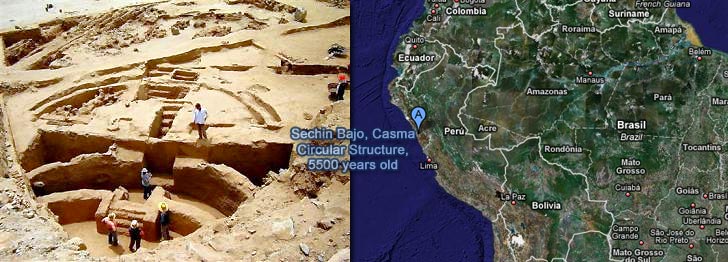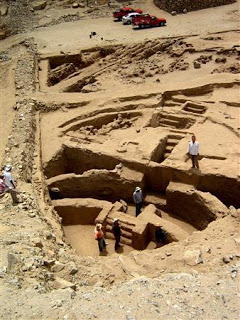Archaeologists find 5,500-year-old plaza in Peru
A recent discovery in Peru uncovered an ancient and very old settlement that dates back more than five thousand years to a period long before Europeans settled in the Americas.
Archaeologists say the site, uncovered amid a complex of ruins known as Sechin Bajo, is a major discovery that could help reshape their understanding of the continent’s pre-Columbian history.
Carbon dating by a German and Peruvian excavation team indicates that the circular plaza is at least 5,500 years old, dating to about 3,500 BC, said Cesar Perez, an archaeologist at Peru’s National Institute of Culture who supervised the dig.

That would make it older than the Great Pyramid of Giza.
Sechin Bajo, 230 miles north of the capital, Lima, thus eclipses the ancient Peruvian citadel of Caral, some 5,000 years old, as the New World’s oldest known settlement.
“This has tremendous importance, both in Peru and internationally,” Perez said by cellphone from the area. “We think it’s the oldest urban site found in the Americas.”
Word of the discovery was first published Sunday in the Peruvian daily El Comercio.
“The findings in Sechin Bajo, especially in the buried circular plaza, have demonstrated that there is construction from 5,500 years ago,” Peter R. Fuchs, a German archaeologist who worked at the site, told the newspaper. “Whoever built Sechin Bajo had a good knowledge of architecture and construction.”
Much of the hidden plaza was uncovered this year, and a great deal of excavation remains to be done, Perez said. Relatively little is known about the people who lived there.
The plaza, 33 to 39 feet across, may have been a site for gatherings, perhaps a kind of ceremonial centre. It was built of rocks and adobe bricks.
Successive cultures lived in the area and built over the site.


Earlier finds in the Sechin Bajo area, in the Casma Valley of Peru’s Ancash region, had been dated at more than 3,000 years old. But the circular plaza pushes the area’s settlement date back considerably.
Peru is perhaps best known to outsiders as the cradle of the Inca empire, which stretched from modern-day Chile to Ecuador. But the Incas were relative latecomers in Peru’s long history of human settlement, rising to prominence in the 15th century before being conquered by the Spanish in the early 16th century.
Before the Inca, Peru was home to various civilizations that left a rich legacy of ruins, pottery, tombs and artefacts. Teams of archaeologists are at work throughout the country, including the bustling capital.
Scientists say settlements were beginning to grow in Peru about the time of urbanization in such cradles of civilization as Mesopotamia, Egypt and India.





